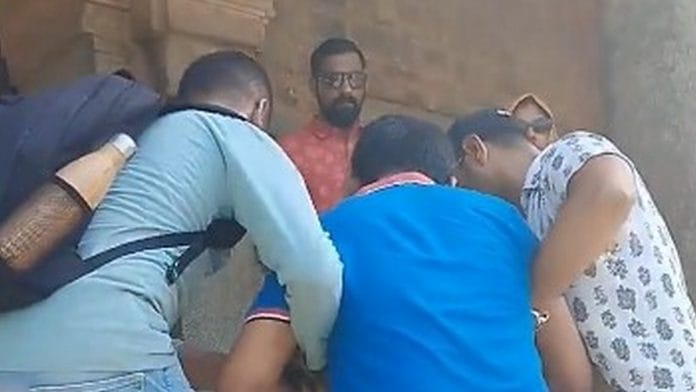Last Sunday, I participated in a heritage walk at Humayun’s Tomb, but because I was half an hour late, my group members could not accompany me to Isa Khan Tomb in the complex. It turned out to be an ordeal since Isa Khan Tomb was not at all wheelchair accessible.
What confronted me were 3-4 steps to climb, followed by another 3-4 steps to descend, then a flat road, and finally, another 2-3 steps to reach Isa Khan’s Tomb. Some kind strangers immediately jumped in to help me. A boy lifted me in his arms and two girls carried my heavy battery-operated wheelchair. But a sense of apology and guilt engulfed me because I had to depend on their help to access Isa Khan Tomb. I even blamed myself for visiting Humayun’s Tomb. While coming back from Isa Khan Tomb, my group members helped me climb the stairs, which had no railing support, and lifted my wheelchair.
It was a horrible experience for me because, despite having a battery-operated wheelchair, I had to depend on others to access the monument. There were also no tactile paths and braille signboards for visually impaired visitors.
Although such accessibility barriers for people with disability are common across public places in India, I was still sorely disappointed because I had started to become optimistic after my recent visits to Red Fort, Qutub Minar, and Lodhi Garden. These places have been made largely (even if not fully) wheelchair accessible through ramps, although they too lack tactile paths, braille signboards, and sign language interpreters.
This indicates our society’s limited understanding of disability access, which seems to extend only to ramps and lifts. And this is also manifested in the actions of the Archaeological Survey of India, even in UNESCO World Heritage Sites like Red Fort, Qutub Minar, and Humayun’s Tomb. It should be noted that UNESCO urges all countries to enable the “full and equal participation of persons with disabilities in all spheres of society”, in accordance with the UN Convention on the Rights of Persons with Disabilities (CRPD) by the year 2030.
But the gulf between reality and rules or recommendations only keeps growing.
Also Read: Disability should be Modi 3.0’s top priority. Focus on 6 key areas for reform
Gap between theory & practice
The Rights of Persons with Disabilities Act 2016 stipulates that all newly constructed public buildings must be made accessible. It also mandates that existing public buildings should be renovated to meet the accessibility requirements of persons with disabilities (PWDs).
However, the gap between theory and practice seems to be widening with each passing day for PWDs. While we may have the best rulebook for PWDs in theory, this makes no difference in the lives of people like me until and unless policymakers work to translate these rules into practice.
These accessibility barriers for persons with disabilities are not restricted to historical places but are everyday challenges that we encounter in workplaces, educational institutions, and public places.
Unfortunately, disability is often an afterthought for people in our society. People only try to understand the challenges of PWDs after seeing us in public places and that too with an attitude of sympathy rather than empathy. There is a subtle difference between the two terms. Sympathy means feeling sorry for someone facing a difficulty, while empathy means trying to understand a person’s problem by putting oneself in their place.
Also Read: Rajya Sabha seats, budget allocation — disability rights groups issue unique manifesto
Fighting a culture of discrimination
Inclusive education needs to start from school onwards, perhaps in the form of introducing a chapter on disability in textbooks. Unfortunately, the sad reality is that the schools in India often blatantly discriminate against persons with disabilities during the admission process. I have been a victim of this too. Due to my father’s transferable job, I had to undergo a lot of problems getting admission in a new school because of my disability.
There are many problems of exclusion for persons with disability in society. We are not only excluded, but are also invisible in the sense that our presence is not even recognised by the people around us. Any move toward an inclusive discourse would require collective efforts on the part of the government, policymakers, and civil society activists to establish us as equal citizens of the country. This should be done without creating hierarchies in the rights-based discourse. The rights of all marginalised groups must be spoken of in the same voice.
Let us start this process by expanding the scope of Article 15—which prohibits discrimination on the grounds of religion, sex, caste, race, and place of birth—to include disability within its ambit. This would give persons with disabilities recognition as equal citizens of the country.
We would do well to remember the words of Dr BR Ambedkar: “Lost rights are never regained by appeals to the conscience of the usurpers, but by relentless struggle… Goats are used for sacrificial offerings and not lions.”
Shorya Sood is pursuing a PhD in political science from the Centre for Political Studies, JNU, and is also a disability rights activist. He tweets @shorya1007. Views are personal.
(Edited by Asavari Singh)






